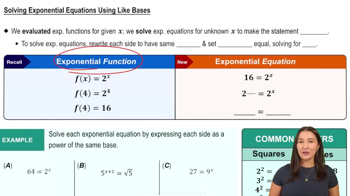Table of contents
- 0. Review of Algebra4h 16m
- 1. Equations & Inequalities3h 18m
- 2. Graphs of Equations43m
- 3. Functions2h 17m
- 4. Polynomial Functions1h 44m
- 5. Rational Functions1h 23m
- 6. Exponential & Logarithmic Functions2h 28m
- 7. Systems of Equations & Matrices4h 6m
- 8. Conic Sections2h 23m
- 9. Sequences, Series, & Induction1h 19m
- 10. Combinatorics & Probability1h 45m
6. Exponential & Logarithmic Functions
Solving Exponential and Logarithmic Equations
Problem 27b
Textbook Question
Solve each equation. In Exercises 11–34, give irrational solutions as decimals correct to the nearest thousandth. In Exercises 35-40, give solutions in exact form. See Examples 1–4. 0.05(1.15)^x = 5
 Verified step by step guidance
Verified step by step guidance1
<Step 1: Start by isolating the exponential expression. Divide both sides of the equation by 0.05 to get (1.15)^x = 100.>
<Step 2: To solve for x, take the logarithm of both sides. You can use either the natural logarithm (ln) or the common logarithm (log). For example, log((1.15)^x) = log(100).>
<Step 3: Apply the power rule of logarithms, which states that log(a^b) = b*log(a). This gives you x*log(1.15) = log(100).>
<Step 4: Solve for x by dividing both sides of the equation by log(1.15). This results in x = log(100) / log(1.15).>
<Step 5: Use a calculator to evaluate the expression log(100) / log(1.15) to find the value of x, rounding to the nearest thousandth as needed.>
Recommended similar problem, with video answer:
 Verified Solution
Verified SolutionThis video solution was recommended by our tutors as helpful for the problem above
Video duration:
3mPlay a video:
Was this helpful?
Key Concepts
Here are the essential concepts you must grasp in order to answer the question correctly.
Exponential Equations
Exponential equations are equations in which variables appear as exponents. To solve these equations, one often uses logarithms to isolate the variable. In the given equation, the term (1.15)^x indicates that x is in the exponent, which requires logarithmic manipulation to solve for x.
Recommended video:

Solving Exponential Equations Using Logs
Logarithms
Logarithms are the inverse operations of exponentiation and are used to solve equations where the variable is an exponent. The logarithm of a number is the exponent to which a base must be raised to produce that number. In this case, applying logarithms will help to transform the exponential equation into a linear form, making it easier to isolate and solve for x.
Recommended video:

Logarithms Introduction
Rounding and Decimal Approximation
Rounding is the process of reducing the number of digits in a number while maintaining its value as closely as possible. In this exercise, solutions must be provided as decimals rounded to the nearest thousandth, which means keeping three digits after the decimal point. Understanding how to round correctly is essential for presenting the final answer in the required format.
Recommended video:

The Number e

 4:46m
4:46mWatch next
Master Solving Exponential Equations Using Like Bases with a bite sized video explanation from Callie
Start learningRelated Videos
Related Practice












